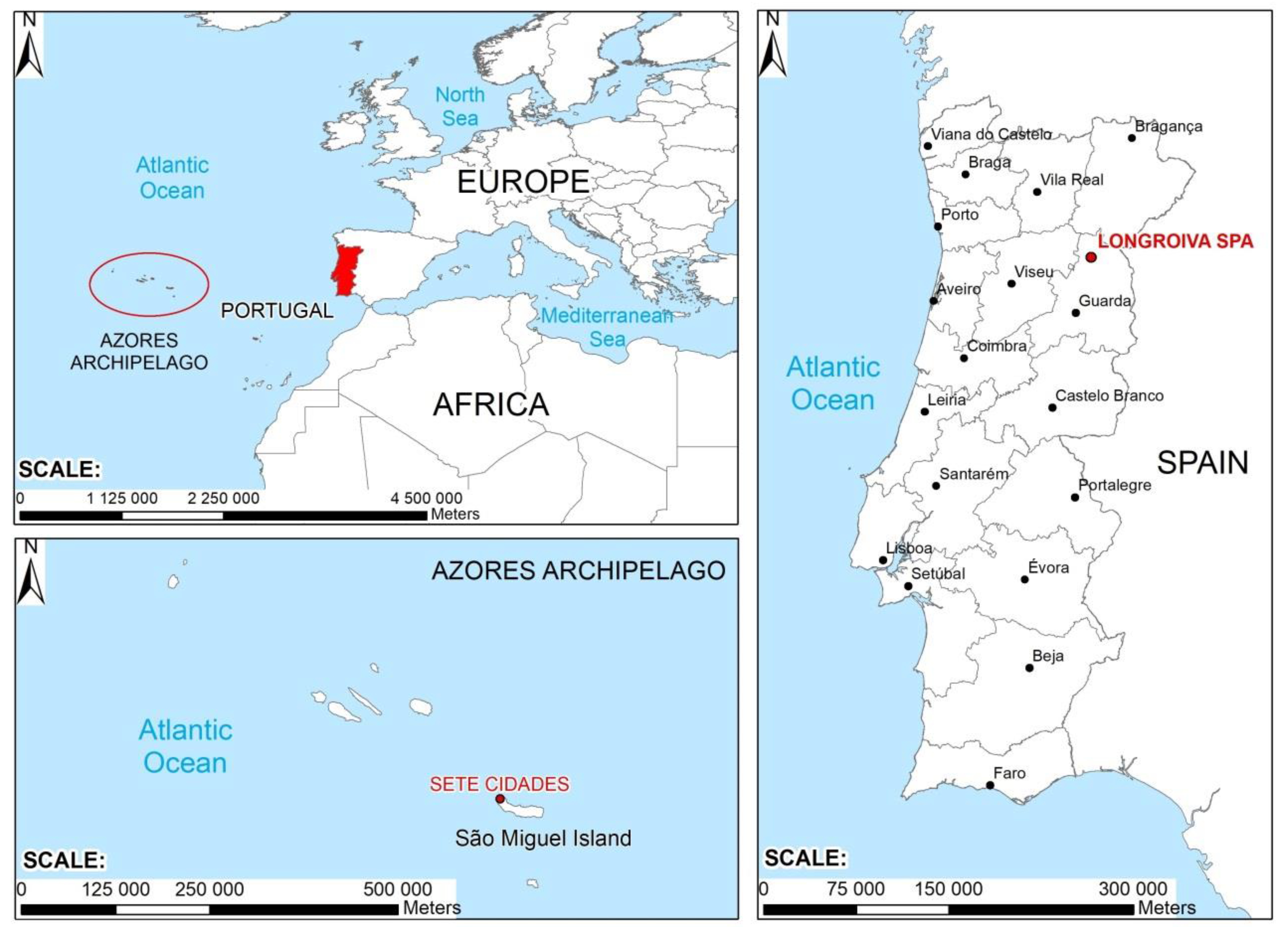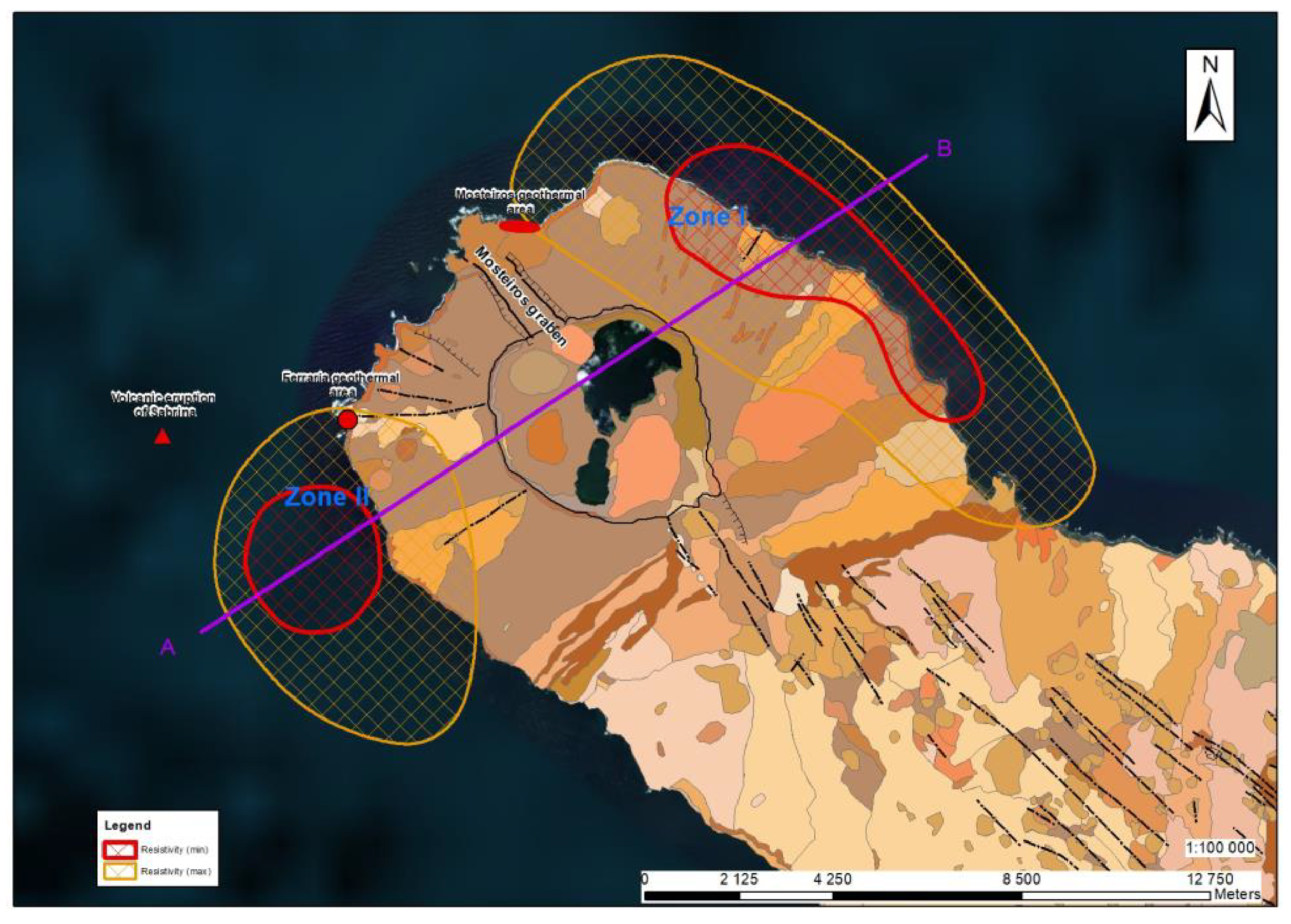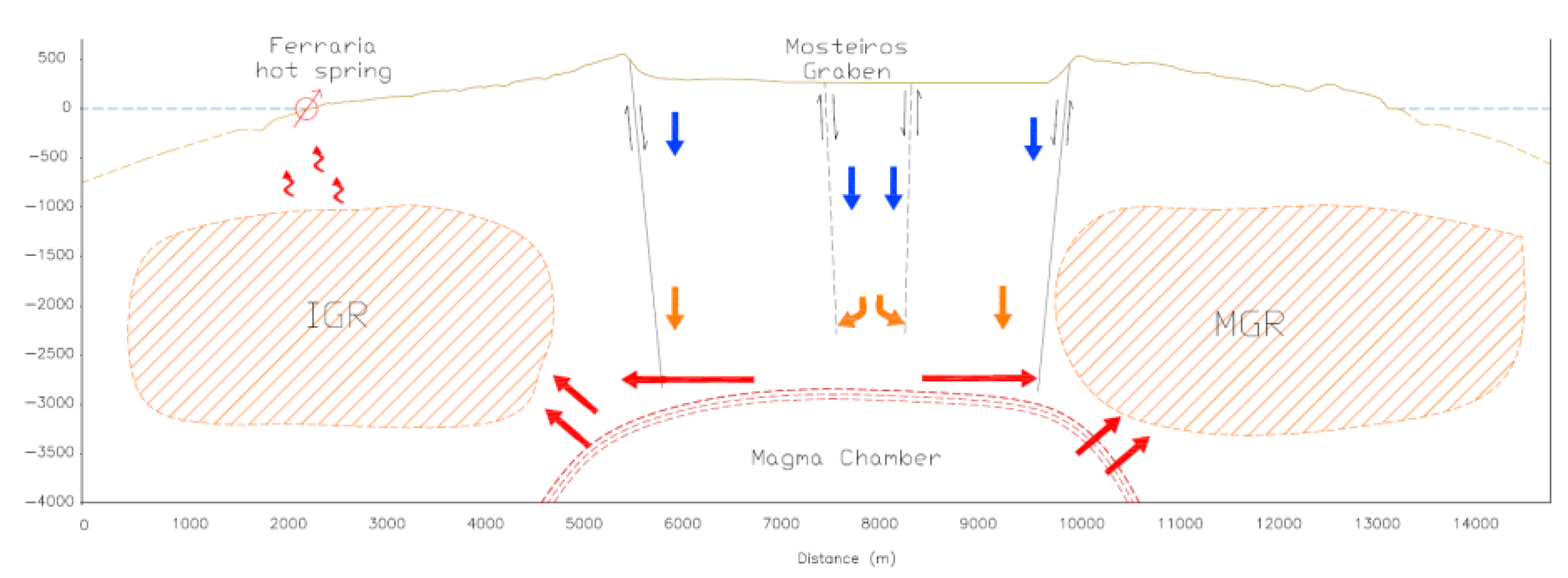Power Production Estimates from Geothermal Resources by Means of Small-Size Compact Climeon Heat Power Converters: Case Studies from Portugal (Sete Cidades, Azores and Longroiva Spa, Mainland)
Abstract
:1. Introduction
2. Power Production by Climeon Technology
3. Case Studies
3.1. Power Potential Evaluation Methodology
- H = Stored heat (kJ).
- A = Resource area (m2).
- h = Reservoir thickness (m).
- The r and w subscripts symbolize rock and water (fluid).
- Ti = Average reservoir temperature (°C).
- Tf = Base (rejected or abandoned) temperature (°C).
- C = Specific heat capacity (kJ/kg °C).
- ρ = Density (kg/m3).
- ϕ = Porosity.
- P = Power plant capacity (kW).
- Rf = Recovery factor.
- η = Conversion efficiency.
- F = Plant capacity factor.
- L = Plant life (s).
3.2. Sete Cidades Site
- (a)
- Proven − P90 or 90% probability: the minimum value.
- (b)
- Proven + Probable − mode (most likely) or median (P50 or 50%).
- (c)
- Proven + Probable + Possible − P10 or 10% probability: the maximum value.
3.3. Longroiva Spa Site
4. Discussion
5. Conclusions
Author Contributions
Funding
Acknowledgments
Conflicts of Interest
References
- EGEC (European Geothermal Energy Council). EGEC Geothermal Market Report 2017. 2018. Available online: https://www.egec.org/media-publications/egec-geothermal-market-report-2017/ (accessed on 1 October 2018).
- Dickson, M.H.; Fanelli, M. (Eds.) Geothermal Energy: Utilization and Technology; UNESCO Renewable Energy Series: Paris, France, 2003; 205p. [Google Scholar]
- Gupta, H.K.; Roy, S. Geothermal Energy an Alternative Resource for the 21st Century; Elsevier: Boston, MA, USA, 2006. [Google Scholar]
- DiPippo, R. Geothermal Power Plants: Principles, Applications, Case Studies and Environmental Impact, 3rd ed.; Elsevier: Oxford, UK, 2012. [Google Scholar]
- Zarrouk, S.J.; Moon, H. Efficiency of geothermal power plants: A worldwide review. Geothermics 2014, 51, 142–153. [Google Scholar] [CrossRef]
- Climeon. Climeon Heat Power Systems. 2019. Available online: https://climeon.com/wp-content/uploads/2017/04/Climeon-Tech-Product-Sheet.pdf (accessed on 15 April 2019).
- Havsed, R. A Modular and Vacuum Based ORC for Low Temperature Geothermal Power; GRC Transactions: Reno, NV, USA, 2018; Volume 42, ISBN 978-1-5108-7585-2. [Google Scholar]
- Kaplan, U. Organic Rankine Cycle Configurations. In Proceedings of the European Geothermal Congress, Unterhaching, Germany, 30 May–1 June 2007. [Google Scholar]
- Franco, A.; Vieira, N.V.; Ponte, C.P. Geothermal Developments in Pico Alto, Terceira Island, Portugal. In GRC Transactions; GRC Geothermal Library: Davis, CA, USA, 2017; Volume 41. [Google Scholar]
- Trota, A. Crustal Deformation Studies in S. Miguel and Terceira Islands (Azores). Volcanic Unrest Evaluation in Fogo/Congro Area (S. Miguel). Ph.D. Thesis, University of Açores, Açores, Portugal, 2009. [Google Scholar]
- Coelho Ferreira, P.J.; Ferreira Gomes, L.M.; Oliveira, A.S.C.; Carvalho, P.E.M. Contribution to the Knowledge of the Geothermal Potential of the Municipality of Meda (Portugal). In Proceedings of the World Geothermal Congress, Melbourne, Australia, 19–24 April 2015. [Google Scholar]
- Ferreira Gomes, L.M.; Ferreira Guedes, J.; Gomes da Costa, T.C.; Coelho Ferreira, P.J.; Neves Trota, A.P. Geothermal potential of Portuguese granitic rock masses: Lessons learned from deep boreholes. Environ. Earth Sci. 2015, 73, 2963–2979. [Google Scholar] [CrossRef]
- DGT. Direção-Geral do Território. Carta Administrativa Oficial de Portugal (CAOP), Shapefile; DGT: Lisboa, Portugal, 2017. [Google Scholar]
- Franz, P.; Neville-Lamb, M.; Azwar, L.; Quinao, J. Calculation of Geothermal Stored Heat from a Numerical Model for Reserve Estimation. In Proceedings of the World Geothermal Congress, Melbourne, Australia, 19–25 April 2015. [Google Scholar]
- Sarmiento, Z.F.; Steingrimsson, B. Computer programme for resource assessment and risk evaluation using Monte Carlo simulation. In Short Course on Geothermal Project Management and Development in Uganda; UNU-GTP: San Salvador, El Salvador; LaGeo: San Salvador, El Salvador, 2008; pp. 1–11. [Google Scholar]
- Williams Colin, F. Evaluating the Volume Method in the Assessment of Identified Geothermal Resources; Geothermal Resources Council Transactions: Portland, OR, USA, 2014; Volume 38, ISBN 9781634394673. [Google Scholar]
- Global Country Boundaries (Arcgis by Esri). Global Country Boundaries from DIVA-GIS. Shapefile from jiangliangcun@gmail.com_ucsb. Available online: https://www.arcgis.com/ home/item.html?id=2ca75003ef9d477fb22db19832c9554f (accessed on 8 May 2019).
- Johnson, C.L.; Wijbrans, J.R.; Constable, C.G.; Gee, J.; Staudigel, H.; Tauxe, L.; Forjaz, V.; Salgueiro, M. 40Ar/39Ar ages and paleomagnetism of São Miguel lavas, Azores. Earth Planet. Sci. Lett. 1998, 160, 637–649. [Google Scholar] [CrossRef]
- Abdel-Monem, A.; Fernandez, L.A.; Boone, G.M. K-Ar ages from the eastern Azores Group (Santa Maria, São Miguel and the Formigas Islands). Lithos 1975, 8, 247–254. [Google Scholar] [CrossRef]
- Queiroz, G.; Gaspar, J.L. Stratigraphy of Sete Cidades Volcano (S. Miguel Island, Azores). In 1a Assembleia Luso-Espanhola de Geodesia e Geofísica, Sessão S09; Vulcanologia Física: Almeria, Espanha, 1998. [Google Scholar]
- Moore, R.B.; Rubin, M. Radiocarbon dates for lava flows and pyroclastic deposits on São Miguel, Azores. Radiocarbon 1991, 33, 151–164. [Google Scholar] [CrossRef]
- Queiroz, G. Vulcão das Sete Cidades (S. Miguel, Açores): História Eruptiva e Avaliação do Hazard. Tese de Doutoramento no ramo de Geologia, Especialidade de Vulcanologia, Departamento de Geociências. Ph.D. Thesis, Universidade dos Açores, Ponta Delgada, Portugal, 1997. [Google Scholar]
- Beier, C.; Haase, K.M.; Hansteen, T.H. Magma Evolution of the Sete Cidades volcano, São Miguel, Azores. J. Pet. 2006, 47, 1375–1411. [Google Scholar] [CrossRef]
- Insulana, A. Ilha Sabrina e a Erupção Submarina em S. Miguel de 1811. Insulana 1951, 7, 260–265. [Google Scholar]
- Machado, F. Acid Volcanoes of San Miguel, Azores. Bull. Volcanol. 1972, 36, 319–327. [Google Scholar] [CrossRef]
- Freire, P. Águas minerais da Ilha de S. Miguel (Açores): Caracterização Hidrogeológica e Implicações para a Monitorização Vulcanológica. Master’s Thesis, Universidade dos Açores, Ponta Delgada, Açores, Portugal, 2006. [Google Scholar]
- Carvalho, M.R.; Mateus, A.; Nunes, J.C.; Carvalho, J.M. Chemistry of the Ferraria thermal water, S. Miguel Island, Azores: Mixing and precipitation processes. Environ. Earth Sci. 2011, 64, 539–547. [Google Scholar] [CrossRef]
- Ferreira, T.; Gaspar, J.L.; Viveiros, F.; Marcos, M.; Faria, C.; Sousa, F. Monitoring of fumarole discharge and CO2 soil degassing in the Azores: Contribution to volcanic surveillance and public health risk assessment. Ann. Geophys. 2005, 48, 787–796. [Google Scholar] [CrossRef]
- Menezes, P.T.L.; Travassos, J.M.; Marçal, A.J.A.; Monteiro Santos, F.A. 3D magnetotelluric exploration of Sete Cidades Volcano, São Miguel Island, Azores. Interpretation 2017, 5, 219–230. [Google Scholar] [CrossRef]
- Rangel, G. Temperature Model and Tracer Test Analysis for the Ribeira Grande Geothermal System, São Miguel Island, Azores; Reports; UNU GPT: Reykjavik, Iceland, 2014; 28p. [Google Scholar]
- Trota, A.P.N.; Rodrigues, F.C.; Meneses, J.G.A. Insights for the Angra do Heroísmo hydrothermal reservoir conceptual model. Sustain. Water Resour. Manag. 2019, 5, 135–146. [Google Scholar] [CrossRef]
- Sanyal, S.K.; Sarmiento, Z. Booking geothermal energy reserves. Grc Trans. 2005, 29, 467–474. [Google Scholar]
- Ribeiro, A.; Antunes, M.T.; Ferreira, M.P.; Rocha, R.B.; Soares, A.F.; Zbyszewski, G.; Moitinho de Almeida, F.; Carvalho, D.; Monteiro, J.H. Introduction à la Géologie Générale du Portugal; Serviços Geológicos de Portugal: Lisboa, Portugal, 1979; 114p. [Google Scholar]
- Cabral, J. Neotectónica de Portugal continental. Mem. Inst. Geol. Min. 1995, 31, 265. [Google Scholar]
- Cunha, P.; Pereira, D.I. Cenozoic Evolution of the Longroiva—Vilariça Area (NE Portugal); Ciências da Terra (UNL): Lisboa, Portugal, 2000; pp. 91–100. [Google Scholar]
- Vegas, R.; Vicente, G.; Muñoz Martín, A.; Palomino, R. Los corredores de fallas de Régua-Verín y Vilariça: Zonas de transferencia de la deformación intraplaca en la península ibérica. Geotemas 2004, 6, 245–249. [Google Scholar]
- Heredia, N.; Rodríguez-Fernánde, L.R.; Vegas, R.; Vicente, G.; Cloetimgh, S.; Giner, J.; González-Casado, J.M. Cadenas cenozoicas del Noroeste peninsular. In Geología de España; Vera, J.A., Ed.; SGE-IGME: Madrid, Spain, 2004; pp. 619–621. [Google Scholar]
- Vicente, G.; Cloetingh, S.; Van Wees, J.D.; Cunha, P.P. Tectonic classification of Cenozoic Iberian foreland basins. Tectonophysics 2011, 502, 38–61. [Google Scholar] [CrossRef]
- Cabral, J.; Ribeiro, A. Carta Neotectónica de Portugal Continental, Escala 1:1.000.000; Departamento Geologia Faculdade Ciências Lisboa, Serviços Geológicos: Lisboa, Portugal, 1988. [Google Scholar]
- Cabral, J.; Ribeiro, A. Carta Neotectónica de Portugal Continental, Escala 1:1.000.000; Nota Explicativa; Serviços Geológicos: Lisboa, Portugal, 1989; p. 10. [Google Scholar]
- Rockwell, T.; Fonseca, J.; Madden, C.; Dawson, T.; Owen, L.A.; Vilanova, S.; Figueiredo, P. Paleoseismology of the Vilariça segment of the Manteigas-Bragança Fault in Northeastern Portugal. In Palaeoseismology: Historical and Prehistorical Records of Earthquake Ground Effects for Seismic Hazard Assessment; Reicherter, K., Michetti, A.M., Silva, P.G., Eds.; Geological Society: London, UK, 2009; pp. 237–258. [Google Scholar]
- Cunha, P.P. Estratigrafia e Sedimentologia dos Depósitos do Cretácico Superior e Terciário de Portugal Central, a Leste de Coimbra. Ph.D. Thesis, University of Coimbra, Coimbra, Portugal, 1992. [Google Scholar]
- Sequeira, A.J.D.; Cunha, P.P.; Sousa, M.B. A reactivação de falhas, no intenso contexto compressivo desde meados do Tortoniano, na região de Espinhal-Coja-Caramulo (Portugal Central). Comunicações Instituto Geológico Mineiro 1997, 83, 95–126. [Google Scholar]
- SGP. Carta Geológica de Portugal, Escala 1/500000; Serviços Geológicos de Portugal: Lisboa, Portugal, 1992. [Google Scholar]
- LNEG. Carta Geológica de Portugal à Escala 1:500000. 5a Edição da Carta Geológica de Portugal à Escala 1:500000 Publicada Pelos Serviços Geológicos de Portugal em 1992. Unidade de Geologia, Hidrogeologia e Geologia Costeira. Laboratório Nacional de Energia e Geologia, I.P. Lisboa, Portugal. 2019. Available online: http://geoportal.lneg.pt/arcgis/services/CGP500k/MapServer/WMSServer?request=GetCapabilities &service=WMS (accessed on 25 May 2019).
- Ferreira Gomes, L.M. Modelos Geohidráulicos de Águas Minerais e de Nascente—Casos de Estudo da Região Centro. In Águas Minerais Naturais e de Nascente da Região Centro; José, S.C., Ed.; Mare Liberum: Aveiro, Portugal, 2012; pp. 185–206. [Google Scholar]
- Silva, J.J.R.F.; Almeida, J.D. Relatório de Análise. In Água das Caldas de Longroiva (Nascente Sulfúrea); Relatório; Universidade da Beira Interior: Covilhã, Portugal, 1970; 10p. [Google Scholar]
- Coelho Ferreira, P.J.; Ferreira Gomes, L.M.; Carvalho, P.E.M.; Oliveira, A.S. Water quality in deep and confined aquifer systems of granite rocks—The case of sulphurous water from Longroiva, Portugal. In Proceedings of the International Conference on Civil Engineering (Towards a Better Environment)—CE13, Covilhã, Portugal, 26–29 May 2013. [Google Scholar]
- Coelho Ferreira, P.J. Modelação de Sistemas Geohidráulicos Profundos Associados a Fraturas Extensas da Região da Meda. Ph.D. Thesis, University da Beira Interior, Covilhã, Portugal, 2019. in press. [Google Scholar]
- Robertson, E.C. Thermal Properties of Rocks; United States Department of the Interior Geological Survey, United Open-File Report 88-441; U.S. Geological Survey: Reston, VA, USA, 1988; 106p. [CrossRef]
- Jumikis, A.R. Rock Mechanics, 2nd ed.; Trans Tech Publications: Houston, TX, USA, 1983; 613p. [Google Scholar]
- DGEG. Geotermia—Energia Renovável em Portugal. In Brochura da DGEG, Direção Geral de Energia e Geologia, 1st ed.; DGEG: Lisboa, Portugal, 2017; 54p. [Google Scholar]







| Characteristics | One Module 150 kWe | Power Block 1 MWe (7 Modules) |
|---|---|---|
| Module | ||
| Height (mm) | 2270 | 2270 |
| Depth (mm) | 2105 | 2105 |
| Width (mm) | 2085 | 14,700 |
| Total weight (kg) | 9000 | 63,000 |
| Electrical Cabinet | ||
| Height (mm) | 2100 | 2100 |
| Depth (mm) | 600 | 600 |
| Width (mm) | 2200 | 13,600 |
| Total weight (kg) | 1200 | 6100 |
| Heating Circuit | ||
| Module flange connection ISO | DN125/PN10 | DN125/PN10 |
| Flow rate liter/second | 10–50 | 70–350 |
| Inlet temperature maximum °C | 120 | 120 |
| Cooling Circuit | ||
| Module flange connection ISO | DN125/PN6 | DN125/PN6 |
| Flow rate liter/second | 10–50 | 70–350 |
| Minimum cooling inlet temperature °C | 0 | 0 |
| Maximum cooling inlet temperature °C | 35 | 35 |
| Electrical Specification | ||
| Maximum net output power kW | 150 | 1050 |
| Voltage selectable V | 400/690 | 400/690 |
| Frequency selectable Hz | 50/60 | 50/60 |
| Items | Units | Most Likely | Min | Max | Probability Distribution |
|---|---|---|---|---|---|
| Area (two zones, I and II) | km2 | 53 | 26 | 78 | triangular |
| Thickness | m | 1000 | 500 | 1500 | triangular |
| Rock density | kg/m3 | 2500 | 2000 | 3000 | triangular |
| Porosity | ad | 0.15 | 0.1 | 0.2 | triangular |
| Recovery factor | ad | 0.035 | 0.01 | 0.06 | triangular |
| Rock specific heat | kJ/kg °C | 1 | constant | ||
| Temperature | °C | 230 | 220 | 250 | triangular |
| Fluid density | kg/m3 | 827.1 | constant | ||
| Conversion efficiency | ad | 11.5 (6.3) | (3.6) | (8.2) | constant/(triangular) |
| Fluid specific heat (constant pressure) | kJ/kg °C | 4.9 | constant | ||
| Plant life | years | 30 | constant | ||
| Load factor | ad | 0.95 | constant | ||
| Rejection temperature | °C | 120 | constant |
| Unit | Proven Reserves (P90) MWe | Proven + Probable (P50) MWe | Proven + Probable + Possible (P10) MWe |
|---|---|---|---|
| Climeon module | 5.66 | 7.03 | 9.26 |
| Binary power plant | 2.04 | 3.56 | 6.02 |
| Items | Units | Most Likely | Min | Max | Probability Distribution |
|---|---|---|---|---|---|
| Area | km2 | 37 | 30 | 60 | triangular |
| Thickness | m | 400 | 250 | 500 | triangular |
| Rock density | kg/m3 | 2600 | 2530 | 2620 | triangular |
| Porosity | ad | 0.02 | 0.01 | 0.04 | triangular |
| Recovery factor | ad | 0.05 | constant | ||
| Rock specific heat | kJ/kg °C | 1 | constant | ||
| Temperature | °C | 110 | 100 | 120 | triangular |
| Fluid density | kg/m3 | 951 | constant | ||
| Conversion efficiency | ad | 9.6 (1.5) | 7.7 (0) | 11.5 (3.0) | triangular |
| Fluid specific heat (constant pressure) | kJ/kg °C | 4.2 | constant | ||
| Plant life | years | 30 | constant | ||
| Load factor | ad | 0.95 | constant | ||
| Rejection temperature | °C | 70 | constant |
| Unit | Proven Reserves (P90) MWe | Proven + Probable (P50) MWe | Proven + Probable + Possible (P10) MWe |
|---|---|---|---|
| Climeon module | 0.64 | 0.87 | 1.24 |
| Binary power plant | 0.06 | 0.13 | 0.24 |
© 2019 by the authors. Licensee MDPI, Basel, Switzerland. This article is an open access article distributed under the terms and conditions of the Creative Commons Attribution (CC BY) license (http://creativecommons.org/licenses/by/4.0/).
Share and Cite
Trota, A.; Ferreira, P.; Gomes, L.; Cabral, J.; Kallberg, P. Power Production Estimates from Geothermal Resources by Means of Small-Size Compact Climeon Heat Power Converters: Case Studies from Portugal (Sete Cidades, Azores and Longroiva Spa, Mainland). Energies 2019, 12, 2838. https://doi.org/10.3390/en12142838
Trota A, Ferreira P, Gomes L, Cabral J, Kallberg P. Power Production Estimates from Geothermal Resources by Means of Small-Size Compact Climeon Heat Power Converters: Case Studies from Portugal (Sete Cidades, Azores and Longroiva Spa, Mainland). Energies. 2019; 12(14):2838. https://doi.org/10.3390/en12142838
Chicago/Turabian StyleTrota, António, Pedro Ferreira, Luis Gomes, João Cabral, and Peter Kallberg. 2019. "Power Production Estimates from Geothermal Resources by Means of Small-Size Compact Climeon Heat Power Converters: Case Studies from Portugal (Sete Cidades, Azores and Longroiva Spa, Mainland)" Energies 12, no. 14: 2838. https://doi.org/10.3390/en12142838
APA StyleTrota, A., Ferreira, P., Gomes, L., Cabral, J., & Kallberg, P. (2019). Power Production Estimates from Geothermal Resources by Means of Small-Size Compact Climeon Heat Power Converters: Case Studies from Portugal (Sete Cidades, Azores and Longroiva Spa, Mainland). Energies, 12(14), 2838. https://doi.org/10.3390/en12142838







